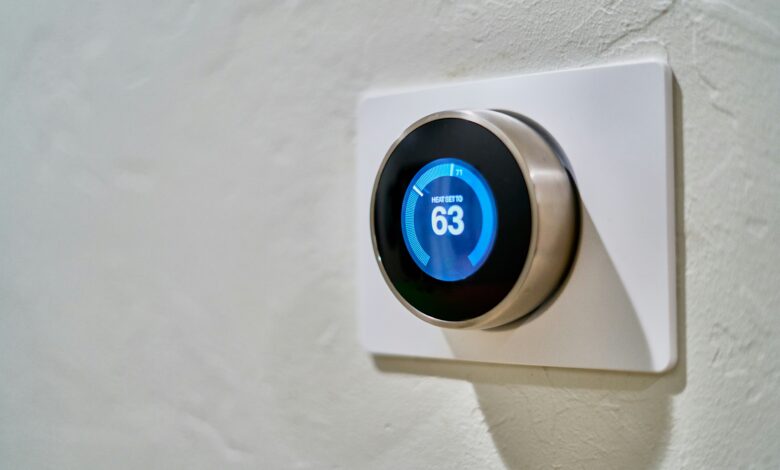
In recent years, the concept of a Smart Thermostat has revolutionized how we think about heating and cooling our homes. These devices go beyond the capabilities of traditional thermostats by incorporating advanced technology to offer greater control, energy efficiency, and convenience. With the increasing focus on smart home technology, Smart Thermostats are becoming a must-have for many households. In this article, we’ll explore what a Smart Thermostat is, its benefits, features, and how to choose the right one for your home.
1. What is a Smart Thermostat?
A Smart Thermostat is a Wi-Fi-enabled device that allows you to control your home’s heating and cooling system remotely through a smartphone app, voice commands, or other smart home systems. Unlike traditional thermostats, which require manual adjustments, Smart Thermostats can learn your schedule and preferences over time. They can automatically adjust the temperature to optimize comfort and energy savings.
These devices are designed to be user-friendly, with intuitive interfaces that make it easy to set up and control. Many Smart Thermostats come with features like touch screens, motion sensors, and even geofencing, which adjusts the temperature based on your location. The ability to connect to the internet means they can receive updates and new features, making them a long-term investment for your home.
2. Benefits of Using a Smart Thermostat
1. Energy Savings and Cost Efficiency
One of the biggest advantages of a Smart Thermostat is its potential for energy savings. By learning your schedule and adjusting the temperature accordingly, these devices can help reduce your energy consumption. For example, a Smart Thermostat can lower the temperature when you’re away from home or asleep and raise it just before you return or wake up. This targeted heating and cooling can significantly reduce your utility bills, making your home more energy-efficient.
2. Remote Control and Accessibility
With a Smart Thermostat, you can control your home’s temperature from anywhere using your smartphone. This is particularly useful if you forget to adjust the thermostat before leaving the house or if you want to change the temperature while on vacation. The ability to access your thermostat remotely adds a layer of convenience that traditional thermostats can’t offer.
3. Integration with Smart Home Systems
Smart Thermostats often integrate seamlessly with other smart home devices, such as smart speakers, lights, and security systems. This integration allows for more comprehensive automation. For instance, you can set up a routine where your thermostat adjusts the temperature, your lights dim, and your security system activates all at once when you leave for work. This kind of integration can make your home feel more cohesive and responsive to your needs.
4. Environmental Impact
Reducing energy consumption not only saves money but also has a positive impact on the environment. By using a Smart Thermostat to optimize your home’s heating and cooling, you can reduce your carbon footprint. Many Smart Thermostats also provide energy usage reports, helping you become more aware of your consumption patterns and encouraging more sustainable habits.
3. Key Features to Look For
When choosing a Smart Thermostat, it’s essential to consider the features that best suit your needs. Here are some key features to look for:
1. Compatibility with HVAC Systems
Not all Smart Thermostats are compatible with every heating and cooling system. Before purchasing, ensure the device will work with your home’s HVAC system. Some Smart Thermostats are designed for specific systems, like heat pumps or multi-stage systems, so check the specifications carefully.
2. User Interface and Ease of Use
A good Smart Thermostat should have an intuitive interface that’s easy to navigate. Whether it’s a touchscreen or a smartphone app, the controls should be straightforward and user-friendly. Look for features like easy scheduling, quick access to temperature adjustments, and clear energy usage reports.
3. Learning Capabilities and Automation
One of the standout features of Smart Thermostats is their ability to learn your preferences and adjust the temperature accordingly. Some models can even detect when you’re home or away using sensors or geofencing technology. This automation can save you time and effort while ensuring your home is always at the right temperature.
4. Integration with Smart Home Ecosystems
If you already have other smart devices in your home, consider a Smart Thermostat that integrates with your existing ecosystem. Popular smart home platforms like Amazon Alexa, Google Assistant, and Apple HomeKit often have compatible Smart Thermostats. This compatibility allows for voice control and more advanced automation routines.
4. How to Choose the Right Smart Thermostat for Your Home
Choosing the right Smart Thermostat involves considering your specific needs and preferences. Here are some tips to help you make the best choice:
1. Determine Your Budget
Smart Thermostats come in a range of prices, from basic models to more advanced options with a plethora of features. Determine your budget before shopping, and consider the potential energy savings that a more expensive model might offer in the long run.
2. Evaluate Your Current HVAC System
Before purchasing a Smart Thermostat, evaluate your current HVAC system to ensure compatibility. Some systems may require additional wiring or accessories, so it’s essential to know what you’re working with.
3. Consider Your Lifestyle
Think about your daily routine and how a Smart Thermostat could make your life easier. If you’re often away from home, a model with robust remote control features might be ideal. If you have a regular schedule, a learning thermostat that adjusts to your habits could save you time and effort.
4. Look for Reviews and Recommendations
Finally, read reviews and seek recommendations from friends, family, or online communities. Real-world experiences can provide valuable insights into the reliability and performance of different Smart Thermostat models.
Conclusion
A Smart Thermostat is a valuable addition to any modern home, offering energy savings, convenience, and integration with other smart devices. By understanding the benefits and key features of Smart Thermostats, you can make an informed decision and choose the right one for your home. Whether you’re looking to save money on energy bills, reduce your environmental impact, or simply enjoy the convenience of remote control, a Smart Thermostat can transform how you manage your home’s climate.




